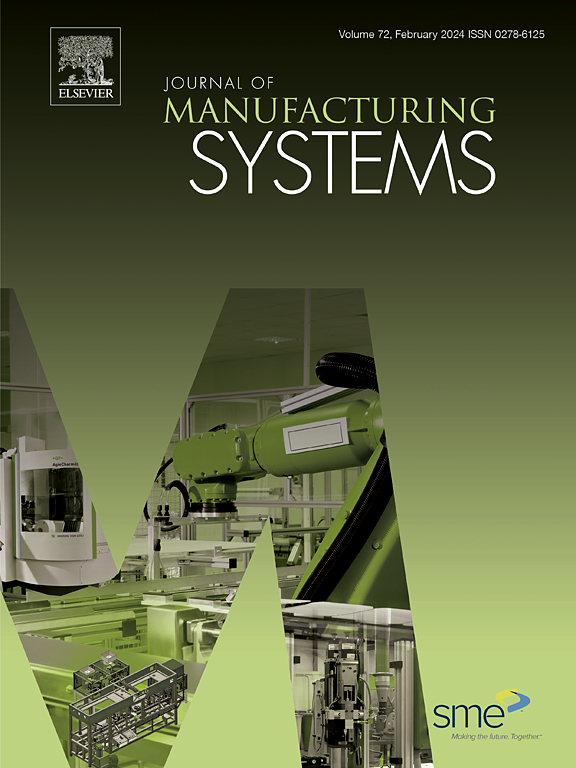Matrix manufacturing system layout and scheduling via graph neural network and multi‐action deep reinforcement learning
IF 14.2
1区 工程技术
Q1 ENGINEERING, INDUSTRIAL
引用次数: 0
Abstract
Matrix manufacturing system (MMS) is a novel production paradigm in Industry 4.0 that provides a highly flexible production environment based on the principles of decentralization, modularity, and unrestricted connectivity. MMS effectively addresses the challenges of personalized customization, which, in turn, imposes stricter demands on the optimization of its layout and scheduling. However, existing research on MMS primarily focuses on constructing theoretical frameworks, with limited attention to practical layout and scheduling optimization. Moreover, layout and scheduling decisions in MMS are highly coupled, and the system state has complex topological structures and dynamics. Conventional vector representation methods struggle to fully capture these intricate relationships, which limits the ability of MMS to address complex production demands. Therefore, to solve the MMS layout and scheduling (MMSLS) problem, this paper proposes an end-to-end multi-action deep reinforcement learning (MADRL) method based on a three-stage embedded heterogeneous graph neural network (HGNN) to learn the optimal policy for parallel decision-making for MMSLS, which aims to minimize makespan. Firstly, the traditional disjunctive graph of flexible scheduling problems is expanded into a heterogeneous graph by incorporating workstation and location nodes, which more intuitively captures the complex associations in MMS between operations and workstations and between workstations and locations. Secondly, we propose a novel HGNN algorithm to enhance representation learning by first transforming MMSLS heterogeneous graph into node-level embeddings and then using heterogeneous graph-level representation vectors as inputs. Finally, the agent sequentially performs actions based on two parameterized sub-policies, operation-workstation actions and location actions, which are trained to learn the optimal MMSLS policy using the proximal policy optimization (PPO) algorithm. Experimental results from both randomized and benchmark instances reveal that the proposed method not only outperforms manually crafted heuristic scheduling rules in solution quality but also exceeds metaheuristic algorithms in computational velocity. Furthermore, it demonstrates strong generalization when handling larger-scale instances.
基于图神经网络和多作用深度强化学习的矩阵制造系统布局与调度
矩阵式制造系统(MMS)是工业4.0时代的一种新型生产模式,它基于分散化、模块化和不受限制的连接原则,提供了高度灵活的生产环境。MMS有效地解决了个性化定制的挑战,这对其布局和调度的优化提出了更严格的要求。然而,现有的MMS研究主要集中在理论框架的构建上,对实际布局和调度优化的关注较少。此外,MMS中的布局和调度决策是高度耦合的,系统状态具有复杂的拓扑结构和动态性。传统的矢量表示方法难以完全捕获这些复杂的关系,这限制了MMS解决复杂生产需求的能力。因此,为了解决MMS布局与调度问题,本文提出了一种基于三阶段嵌入式异构图神经网络(HGNN)的端到端多动作深度强化学习(MADRL)方法,以最小化makespan为目标,学习MMSLS并行决策的最优策略。首先,将柔性调度问题的传统析取图扩展为包含工作站和位置节点的异构图,更直观地捕捉了MMS中操作与工作站之间、工作站与位置之间的复杂关联;其次,我们提出了一种新的HGNN算法,通过将MMSLS异构图转换为节点级嵌入,然后使用异构图级表示向量作为输入来增强表示学习。最后,智能体基于两个参数化子策略(操作工作站操作和位置操作)依次执行操作,并使用近端策略优化(PPO)算法对其进行训练以学习最优MMSLS策略。随机和基准实例的实验结果表明,该方法不仅在求解质量上优于手工制作的启发式调度规则,而且在计算速度上也优于元启发式算法。此外,它在处理更大规模的实例时表现出很强的泛化能力。
本文章由计算机程序翻译,如有差异,请以英文原文为准。
求助全文
约1分钟内获得全文
求助全文
来源期刊

Journal of Manufacturing Systems
工程技术-工程:工业
CiteScore
23.30
自引率
13.20%
发文量
216
审稿时长
25 days
期刊介绍:
The Journal of Manufacturing Systems is dedicated to showcasing cutting-edge fundamental and applied research in manufacturing at the systems level. Encompassing products, equipment, people, information, control, and support functions, manufacturing systems play a pivotal role in the economical and competitive development, production, delivery, and total lifecycle of products, meeting market and societal needs.
With a commitment to publishing archival scholarly literature, the journal strives to advance the state of the art in manufacturing systems and foster innovation in crafting efficient, robust, and sustainable manufacturing systems. The focus extends from equipment-level considerations to the broader scope of the extended enterprise. The Journal welcomes research addressing challenges across various scales, including nano, micro, and macro-scale manufacturing, and spanning diverse sectors such as aerospace, automotive, energy, and medical device manufacturing.
 求助内容:
求助内容: 应助结果提醒方式:
应助结果提醒方式:


